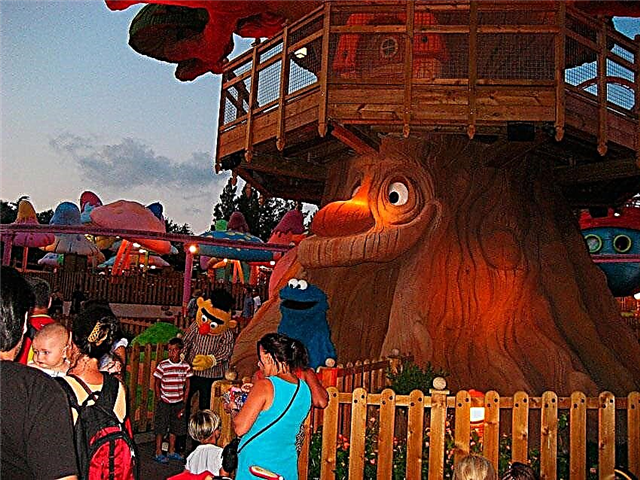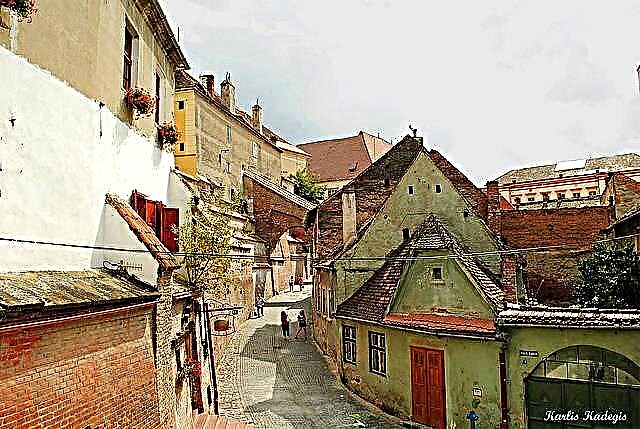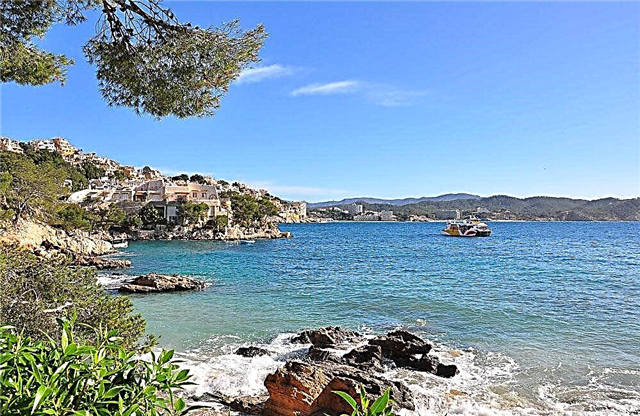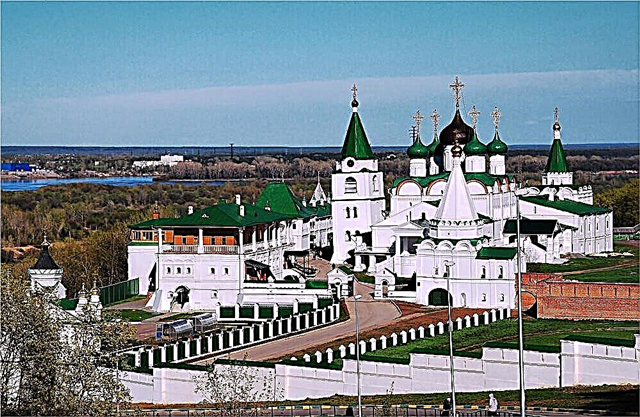Before the revolution, there were many Orthodox sites on the territory of the Nizhny Novgorod region. These lands were famous for their religious traditions, revered saints and specialists in icon painting came from these places. Unlike some other regions, it was not possible to keep any monastery functioning here since the Bolsheviks came to power.
They began to rebuild and restore the monasteries since the 90s. For example, Diveevsky was able to reach the previous level of development and is very popular with pilgrims. The oldest monastery in the region, the Annunciation, has also acquired a second life. New objects appear on the map, like the Pokrovsk monastery.
Operating monasteries of the Nizhny Novgorod region
The most famous male and female abodes. Holy places, list, photos with names and descriptions!
Diveevo monastery
Founded in the 80s of the 18th century in the village of the same name. The holy springs nearby were ennobled, baths built. Among the relics there is an ark with particles of the relics of saints from the Glinskaya desert. Of the icons, the most revered is the Icon of the Mother of God "Tenderness". Seraphim Sarovsky died in front of her. He did a lot for the convent. The Mother of God appeared to him, after which the Holy groove was dug here.
Address: s. Diveevo, st. Soviet, 11
Site: diveevo-monastyr.ru

Spaso-Preobrazhensky monastery
The exact date of foundation is unknown, but the approximate foundation of the monastery appeared in the middle of the 16th century. Located in the city of Arzamas. The cloister was closed from 1927 to 2006. During this time, they managed to organize a hostel, a warehouse and a savings bank inside. After the restoration and the first Christmas liturgy, services began to be held constantly, a governor was appointed. The courtyard is a chapel in honor of the Savior Not Made by Hands.
Address: Arzamas, st. Red Militia, 2
Site: ar-mon.ru

Annunciation Monastery
The oldest monastery in Nizhny Novgorod dates back to 1221. Stands on the banks of the Oka. In the Soviet years, a planetarium was located in the buildings of a closed male monastery. The revival of the monastery began in 1993 with the opening of a theological school within its walls. A porcelain iconostasis is installed in one of the temples of the monastery. A bust of Emperor Alexander III was inaugurated on the territory of the complex in 2013.
Address: per. Mill, 8
Site: blagomm.ru

Zheltovodsky Makariev Monastery
The nunnery was founded in 1433 in the village of the same name. Located on the banks of the Volga. By the time it closed in 1917, about 300 nuns lived here. There were successively an orphanage, a hospital, animal stalls and a warehouse in the monastery. In 1991, the monastery was returned to the Russian Orthodox Church. The cathedral, the gate church and 4 churches have been restored. The fortress walls with towers form an almost even square.
Address: village Makaryevo, st. Embankment, 1
Site: makaryzhelt.cerkov.ru

Oransky Bogoroditsky Monastery
The monastery has been located in the village of the same name since 1634. It is based on the acquisition of the Oran Icon of the Mother of God. Closed in 1920, earlier the monks were shot. During and after the war, a camp for prisoner officers worked on the territory of the monastery. Although the revival of the monastery started in 1993, the buildings were renovated and consecrated in stages until 2016. Some buildings had to be built from scratch.
Address: s. Oranki, st. Postal, 2
Website: orankimon.rf

Pechersky Ascension Monastery
The monastery was founded in the first half of the XIV century in Nizhny Novgorod. For some time, the male abode was the spiritual center of the entire principality. From 1924 to 1994, it housed a dormitory, a cinema and a workshop. The restoration proceeded slowly: in 10 years not all the buildings were rebuilt, the brethren numbered only 14 people. Several valuable icons are kept in local churches, including those donated by Patriarch Kirill.
Address: Nizhny Novgorod, Privolzhskaya Sloboda, 108
Website: www.pecherskiy.nne.ru

Sarov desert
The monastery was founded in the city of the same name at the beginning of the 18th century. Earlier Sarov belonged to the Tambov province, now - to the Nizhny Novgorod region. Among the inhabitants there was also Seraphim of Sarov. With the coming to power of the Bolsheviks, the deserts were closed and its purpose changed many times. After a long break, an Orthodox parish appeared here only in 1990. The monastery itself was opened in 2006. One of the temples was consecrated by Patriarch Alexy II.
Address: Sarov, Prospect Mira, 38
Website: www.sarov-monastery.org

Florishcheva deserts
It has been standing on a hill near the Lukh River since 1651. The monastery was constantly being completed: for example, much later a hospital and a small almshouse appeared here. In 1923, the buildings were partially destroyed. The lands were returned to the Russian Orthodox Church in the 90s, and the monastery began to be restored already in the 21st century. The style and motives typical of the Byzantine masters of the 12th century were used in the design of the temples of the desert.
Address: pos. Frolischi, st. Nagornaya, 3
Website: www.florisheva-pustin.com

Feodorovsky monastery
The 13th century is considered the founding date of the monastery in Gorodets. It began with the acquisition of the icon of the same name. The monastery was abolished in the 17th century, and then reopened. It lasted until 1927. The second recovery came in the 2000s. The cathedral church was rebuilt in 2009 in its original form. The main shrine is a list of the Feodorovskaya Icon of the Mother of God. The four-tier faience iconostasis is also noteworthy.
Address: Gorodets, Proletarskaya square, 34 B
Site: feodorovskiy-monastyr.ru

Amvrosiev Nikolaevsky Dudin Monastery
The male monastery is located in the Bogorodsky district on the right bank of the Oka. It was first mentioned in chronicles in 1408. The monastery was liquidated immediately after the revolution. The recovery came at the beginning of the 2000s. The largest worship cross in the region is installed on the territory of the monastery. Its height is about 9 meters, and its weight is 2 tons. A special staircase and a dirt road lead to the monastery. And holy springs gush from the mountain nearby.
Address: Teteryugino village

Vysokovsky Assumption Monastery
The men's monastery was founded in 1784 as an Old Believer skete. After 15 years, he became a fellow believer. The status of a monastery was obtained in 1920, but already in 1929 the monastery was closed. The monastery is notable for its preserved architectural ensemble in the classicism style. The main buildings: the five-domed Assumption Cathedral, the "falling" bell tower with an observation deck, residential buildings. A full-scale restoration began in 1996.
Address: Uspensky settlement, 19
Site: vk.com/club160782277

Holy Cross Monastery
The nunnery has appeared on maps since the 70s of the XIV century. Like the rest of the monasteries of the region, it was abolished after the revolution. The synod decided to revive it in 2004. At the same time, the monastery cathedral was restored earlier. Shrines are two special crosses. The first one with a particle of the Life-giving Cross of the Lord, the second is painted in the Trinity-Sergius Lavra and has a height of 4.5 meters. There is a parish school and a first-aid post at the monastery.
Address: Nizhny Novgorod, Oksky congress, 2 B
Site: krest.nnov.ru

Pokrovsky monastery
The first monastery of the region, founded after the revolution. It has been located in the village of Lukino since 2000. The first abbess was Abbess Barbara, who stood at the origins of the women's monastery. During the processions of the cross, the Oran Icon of the Mother of God is taken out of the church. The main temple is modestly decorated. Expansion of the territory of the monastery is planned. An important shrine is a reliquary with particles of the relics of more than thirty saints.
Address: s. Lukinoul, st. Ulybysheva, 10 A

Vyksa Iversky Monastery
The convent was founded in 1864 in the city of the same name. By the time of its liquidation in 1919, the monastery was one of the largest in the region. They blew up not only the cathedral, but also the upper tiers of the bell tower. At the same time, nuns died in the cave cells. In 1991, they began to restore the monastery. Miraculously, a list of the Iveron Icon of the Mother of God was saved, which was returned to its rightful place.
Address: Vyksa, st. Krasnoflotskaya, 58
Site: vm1864.ru

Marovsky Holy Cross Monastery
The monastery is located in the Spassky district.There is no exact date of foundation, roughly the monastery appeared in the 17th century. It was ravaged and destroyed several times. Completely closed in 1927. Since nothing remained of the monastery except the foundation of the fortress wall, it was necessary to rebuild it in 2008 from scratch. A plot of almost 72 thousand square meters was allocated for the needs of the brothers. Although the services in the main temple are already underway, the work is not finished yet.
Address: Nizhny Novgorod, Oksky congress, 2 B
Site: krest.nnov.ru

Ostrovoezersky monastery
This nunnery was first mentioned in 1580. Built on the island of Lake Vorsmena. Abolished in the 1930s, the island location did not save the buildings and fortress walls from destruction. Since 1995 it has been protected by the state. Monastic life was resumed here in 2005. The main relics: the icon of the Mother of God Economis and the Athos icon of the Great Martyr Panteleimon with a particle of relics.
Address: Vorsma, lake. Tuscany

Trinity Belbazh Monastery
The monastery is a skete of the Diveyevo monastery. It was founded in 1708 in the village of Belbazh by a personal decree of Peter I. In 1921 it was closed, and the buildings were actively used for other purposes. The former shrines are considered lost. The monastery status was returned in 2009. Two churches, a church and an abbot building have been preserved and repaired. New objects on the territory of the skete are being gradually restored and rebuilt.
Address: s. Belbazh
Site: vk.com/belbazh_monastyr

Iversko-Sofroniev Hermitage
Built in a forest at the end of the 19th century. It did not last long until 1929. In the 90s of the last century, with the assistance of residents of nearby settlements, the revival of a small monastery began. A small female community settled in the desert in 2001. Work on the development of the territory is still underway. A chapel was erected over the grave of the founder of the monastery. The sisters gladly receive pilgrims.
Address: s. Kovaksa, st. North, 54
Site: sofronievapustyn.ru

Ababkovsky monastery
The women's monastery is located on the right bank of the Oka in the village of the same name. It functioned from 1818 to 1928. The monastery was not just closed: its buildings, including temples, were blown up. The territory was given to a rest home. More than 10 years have passed since the transfer of land to the Russian Orthodox Church in the 90s until the start of work on the construction of new Orthodox objects. They rebuilt churches, a bell tower, residential buildings. The main relic is the Icon of St. Nicholas with a particle of relics.
Address: pos. Youth, 25
Website: www.ababkovo.ru

Dalne-Davydovsky monastery
The monastery was founded in the 40s of the last century in the name of the icon of the Mother of God "Satisfy my sorrows." Based on a women's community of 10 sisters. Closed at the end of the 20s of the XX century. Some buildings remained intact. In 2000, the cathedral church was restored, and then the parish one. In 2015, another part of the territory was transferred to the monastery, where the skete of the Vyksa Iversky monastery was previously located.
Address: Davydovo village, st. Monastyrskaya, 211
Website: d-dmonastyr.blogspot.com












